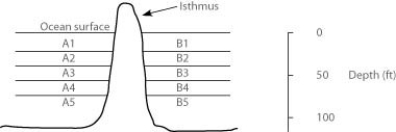Multiple Choice
In the oceans on either side of the Isthmus of Panama are 30 species of snapping shrimp; some are shallow-water species, others are adapted to deep water. There are 15 species on the Pacific side and 15 different species on the Atlantic side. The Isthmus of Panama started rising about 10 million years ago. The oceans were completely separated by the isthmus about 3 million years ago.
In the figure, the isthmus separates the Pacific Ocean on the left (side A) from the Atlantic Ocean on the right (side B) . The seawater on either side of the isthmus is separated into five depth habitats (1-5) , with 1 being the shallowest.
The Panama Canal was completed in 1914, and its depth is about 50 feet. After 1914, snapping shrimp species from which habitats should be most likely to form hybrids as the result of the canal?
A) A5 and B5
B) A3 and B3
C) A1 and B1
D) A1-A3 and B1-B3 have equal likelihoods of harboring snapping shrimp species that can hybridize.
Correct Answer:

Verified
Correct Answer:
Verified
Q1: The peppered moth provides a well-known example
Q12: Suppose that a group of male pied
Q14: The difference between geographic isolation and habitat
Q27: Which of the following statements describes mechanical
Q32: The largest unit within which gene flow
Q35: Use the following description to answer the
Q48: Rocky Mountain juniper (Juniperus scopulorum) and one-seeded
Q58: In the oceans on either side of
Q60: In a hypothetical situation, a certain species
Q66: The phenomenon of fusion is likely to